
Parks have competition for leisure time
Video games, lack of vacation time and increasing gas prices are the main culprits contributing to a steady decrease in attendance to America’s national parks.
In the past five years, according to the National Park Service, there has been a shift in the trend of tourists who visit America’s national parks.
“The Great Smoky Mountains National Park is the No. 1 attended park in the country. People wonder why we maintain our high attendance rates and there are several reasons,” said Nancy Gray, a park ranger and the Great Smoky Mountains National Park spokesperson in Gatlinburg, Tenn.
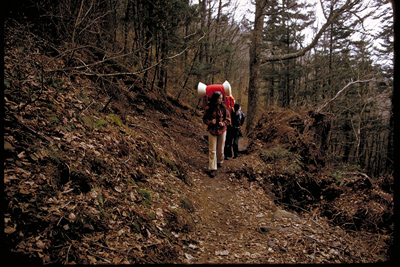 |
Hikers enjoy the Great Smoky Mountains National Park (Photo courtesy of the National Park Service). |
“First of all, we’re close to one-third of the nation’s population, so we have repeat visitors and a constant influx. There is no entrance fee here, as opposed to parks out west,” she added. “And the outlying communities of Pigeon Forge and Gatlinburg are very affordable and accessible to the public. Through the park, we have grown to be partners with the community and become successful in providing a service to the public.”
Only a minority of the parks are maintaining their high visitation rates. This is mostly due to their location near large cities or because they do not charge an admittance fee, which is the case for the Great Smoky Mountains National Park.
“The reason why we cannot charge an entrance fee has to do with the way we were established. We were purchased from the states of North Carolina and Tennessee and from individual majority ownership from lucrative lumber companies,” Gray explained. “The land transferred to the park under the stipulation that no toll fee would be charged in the 1950s and 60s. Thus, because of the road issues in the park, we don’t and can’t charge an entrance fee.”
“Although, we are not affected by a decrease in attendance; there is an epidemic of losing the younger generation and baby boomers to cell phones and high gas prices and people do not want to give up weeks for vacation. A move has been made to short weekend trips at other national parks,” said Gray.
Although the Great Smoky Mountains National Park is not struggling for more tourists with its whopping nine million visitors in 2006, officials struggle with the opposite situation: maintaining the facilities for the large numbers of tourists.
| A trail winds through trees on a mountainside of the Great Smoky Mountains National Park (Photo courtesy of the National Park Service). | 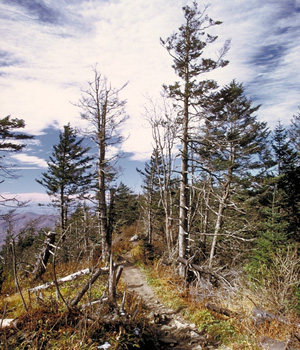 |
“The Law Enforcement Resource Division, which is the security and protection department in the mountains, responds to visitor issues. There is lack of patrol in the backcountry and also for those campers to adhere to the regulations. We need more law enforcement to minimize the ecological footprint left by visitors,” said Gray.
“There is a high use of creating resource impacts because tourists won’t camp in designated areas. It’s a paramount issue because tourists have the mentality of ‘I’m only one person’ and not realizing that thousands of others are doing the same thing. I don’t understand how campers don’t equate the same impact and take responsibility of their actions. All it takes is to abide by the rules,” said Gray about visitors continually damaging the park and camp grounds.
Misperception sometimes contributes to false impressions that are never corrected, such as the case at Yosemite National Park in California.
“In 1997, there was a massive flood closing the park for three months. This contributed to our decrease in visitors in 1996 from over four million to three million. Of course, 9/11 affected flights out here and gas prices never seem to stop rising,” said Scott Gediman, a park ranger and chief of Media Relations and chief spokesperson for Yosemite.
Many park rangers concur that America’s favorite pastime is losing its luster, a result of busy schedules for families.
“When I was a kid, my family would go to a park for a week, but the demographic has shifted. Americans aren’t taking one to two week vacations anymore. More importantly, 8- to 10 year-olds aren’t enamored by nature anymore— they’re disinterested. Hiking is boring and they want to play Xbox,” said Gediman, who has been working at Yosemite for 11 years.
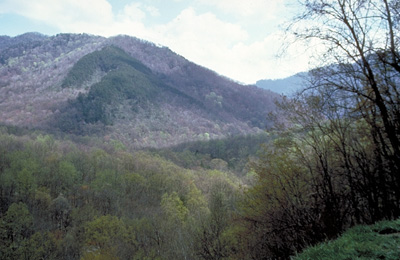 |
The Great Smoky Mountains National Park is in both Tennessee and North Carolina (Photo courtesy of the National Park Service). |
“There have been many studies, not only is technology affecting kids, but kids are over programmed with Little League baseball and soccer. It has become progressive to the point that parents don’t have time to visit the large parks anymore. This study is consistent with Yellowstone as well as the Grand Canyon. The parks that are increasing in attendance are the ones closest to major cities that families are using as day trips. The western parks aren’t seeing the increase that the urban centers are,” explained Gediman.
Vickie Carson, spokesman in public affairs at Mammoth Cave National Park in Kentucky, reconfirmed that Americans are traveling less to national parks.
“Americans are not traveling as much because they have less expendable income,” said Carson.
The Rocky Mountain National Park’s visitation figures have seen the same fate as other national parks; visitation has been flat since 2002 and Kyle Patterson, the spokesperson from the Rockies, also claims it’s due to Americans having less disposable income.
“After 9/11, many tourist destinations saw their visitation decrease including national parks. The economy and families having less disposable income have had more of an impact on our visitation than gas prices.
“Because we are so close to a large population, higher gas prices could actually encourage people to stay closer to home and explore in their backyard rather than drive further distances. Gas prices don’t impact our visitation but impact more remote parks that are further away from a large population,” said Kyle Patterson, the public affairs officer for the Rocky Mountain National Park in Colo.
| A ranger visits with campers at Mammoth Cave National Park (Photo courtesy of the National Park Service). | 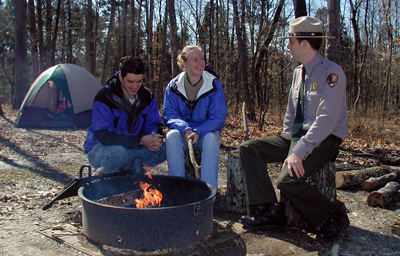 |
“The park needs to continue to incorporate technology to reach visitors especially through our website. We need to continue to outreach to Americans to encourage families and children to experience national parks,” Patterson explained about using technology to their advantage.
Carson, as well as Gediman, stressed that America’s departure from nature coincides with Richard Louv’s novel, Last Child in the Woods. Both reconfirmed the novel’s findings: families do not raise children in the same way as in years past.
“The main issues reflected in the book—the increasingly popularity of electronic games and the web—have altered the way in which families raise children. At Mammoth Cave, we strive for nothing to be simulated; it is the real thing, to get back to the basics. That’s what we strive to uphold for the kids especially. We also have a large environmental program where we get kids into the cave so they use all of their senses,” said Carson.
Last Child in the Woods asserts that children are becoming more disconnected from the woods because instead of spending their summers hiking and fishing, kids are sent to diet and computer camps.
Louv has introduced the notion that kids consider nature an abstraction and not an everyday reality to be enjoyed. The important message of Louv’s novel is that kids should be pushed to use nature as an environment-based education tool. Studies have shown such education can improve standardized test scores and grade-point averages.
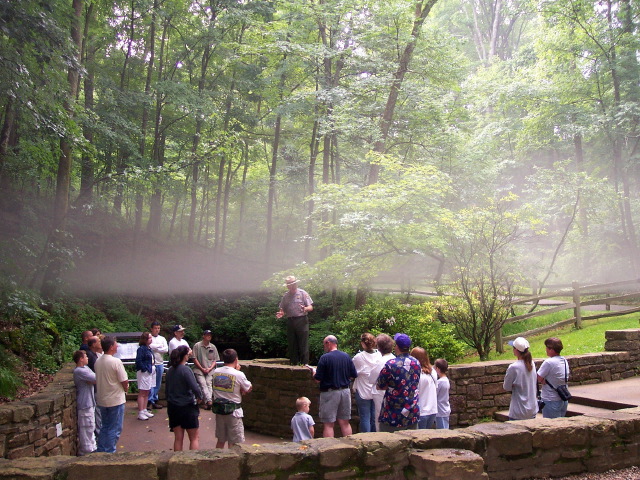 |
A ranger talks with visitors near the entrance of Mammoth Cave at Mammoth Cave National Park (Photo courtesy of the National Park Service). |
According to spokespersons at all three parks, funds are set aside to support an on-site educational program.
“We have a large environmental program with over 16,000 to 17,000 kids a year being educated by rangers in the classroom or within the cave,” said Carson about Mammoth’s Environmental Education Program.
“We’ve had improvements to specific projects at the park, some of the donation funds go to visitor education and resource education for school children,” said Gray about the distribution throughout the park.
The Smokies also has a day-use educational program called “Park As Classrooms” for students in elementary and middle school.
Although the question of declining attendance at parks across the US is debatable, it is evident that park entrance fees are usually quick to blame as the prevailing problem. The spokespersons from Yosemite, Smoky Mountains, the Rockies and Mammoth Cave argue that the money collected in entrance fees are easily reflected in the park and are reasonable.
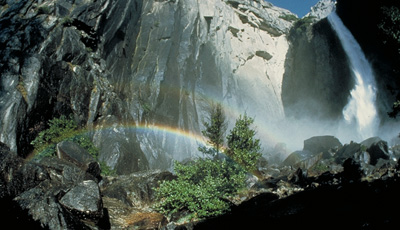 |
A rainbow highlights mountain scenery at Yosemite National Park in California (Photo courtesy of the National Park Service). |
Due to the Fee Demonstration Program, enacted by Congress in 1996, the parks are allowed to keep 80 percent of the entrance fee in order to improve the park. Mammoth Cave has specifically used the percentage for improving the electrical system and rehabilitating the visitor center. The 20 percent is redistributed to the parks in the national park system that cannot charge a fee such as monuments like the Statue of Liberty. Nearly one-third of the national parks cannot charge an admission fee.
“We’re able to serve visitors better through an improved water and electrical system. We’ve replaced the old six-mile cable electrical system with 45 miles of cable which is more intensive and very cumbersome but is more energy efficient,” said Carson about the recent improvements made to Mammoth Cave.
| Campers wait for a meal to be ready at a Mammoth Cave National Park campground in Kentucky (Photo courtesy of the National Park Service). | 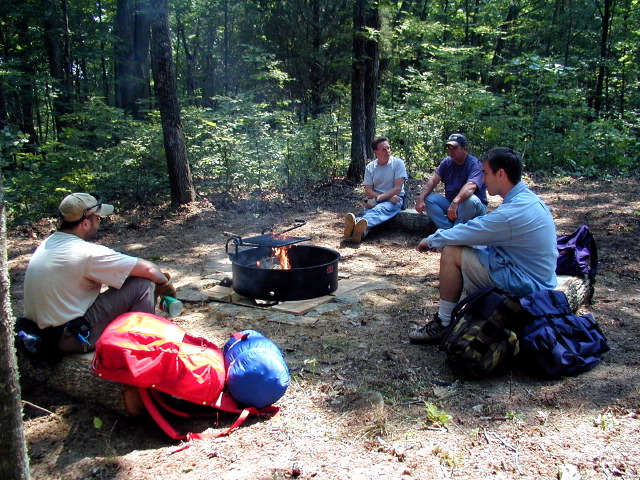 |
“You pay $20 to look at these great exhibits in the visitor center and see the boardwalk across the meadow; the public doesn’t complain about the fee for these projects. It’s nice that people go in and see where the money is going. Of course, I see all of that, and talking to the public they are very accepting,” said Gediman about tourist’s approval with Yosemite’s $20 per car fee.
Americans across the nation can be certain that their national parks are being revamped to
accommodate more tourists with new added technology. The next step will be if Americans will find
the parks appealing and make the trip to visit them.
“If you look at past trends of visitation they certainly indicate that visitation will continue to increase. As our country and the world’s population increases people will continue to seek out refuge in national parks and wilderness areas,” said Patterson about her analysis of the spikes and downfalls of attendance within the national park system.
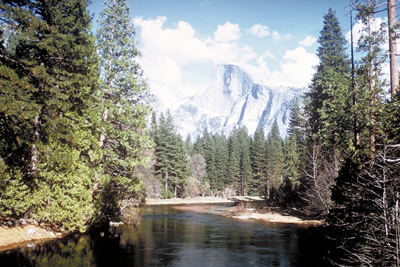 |
A river passes through a forest at Yosemite National Park (Photo courtesy of the National Park Service). |

Comments are Closed